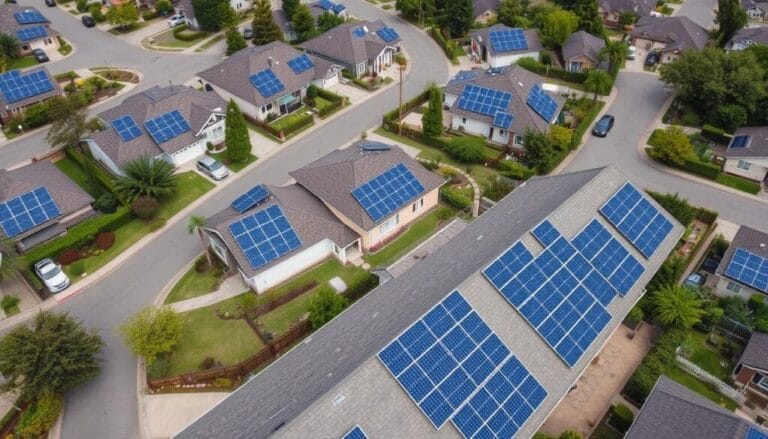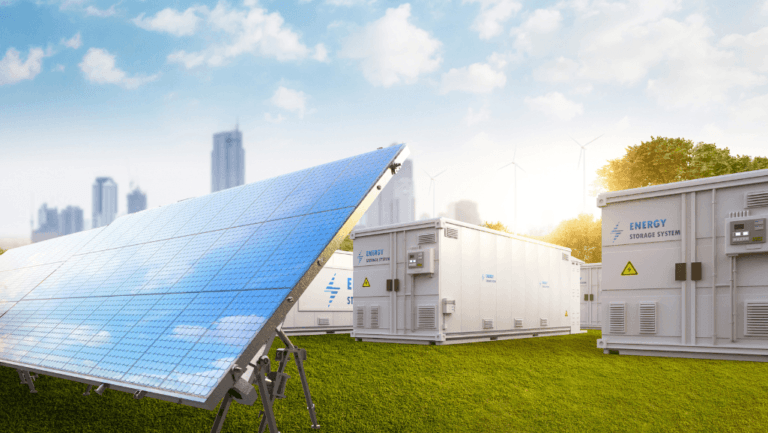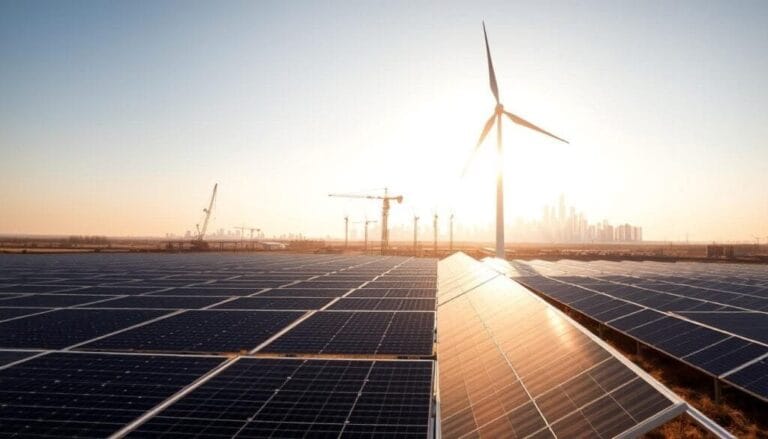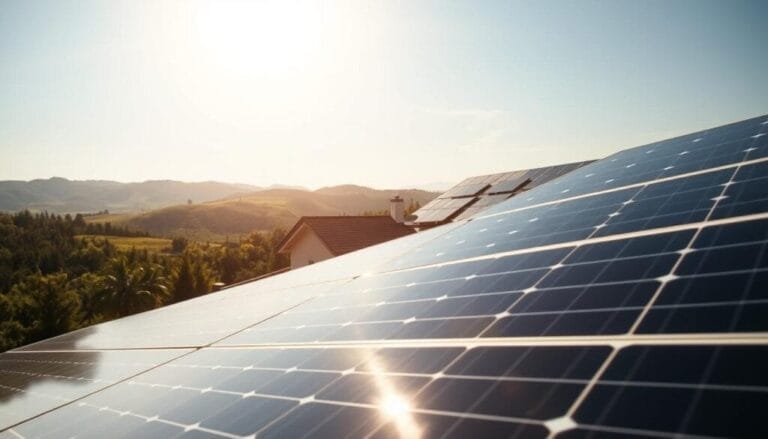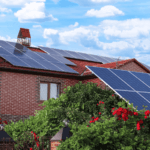Learning about energy basics helps us understand how we use and manage energy resources every day. This guide shows how we convert sources like wind and fossil fuels into the electricity and fuels that power homes, industry, and transport. It also explains how modern energy technology and smarter energy management can lower costs, cut emissions, and make systems more resilient.
At the heart of energy basics is our connection to the sun: the sun fuels the climate and most renewable sources, and it ultimately shapes the energy sun inputs available to the world. That connection explains why efficient ways to capture, convert, and store solar and other resources matter. Using energy wisely protects ecosystems, preserves limited fossil-fuel stocks, and raises the long-term value we get when we use energy.
Key Takeaways
- Understand energy transfer and conservation so you can measure and improve how you use energy.
- Recognize the link between energy services (like heating, lighting, transport) and the resources that supply them — it helps target efficiency gains.
- Adopt sustainable practices and energy technology to reduce reliance on nonrenewable fuels and lower environmental impact.
- Effective energy management combines clear physical metrics (units, flows) with system-level thinking to optimize outcomes.
- Focus investments and behavior on systems that match primary resources (for example, pairing solar panels with batteries) to meet demand responsibly.
Quick action you can take today: run a short home energy audit, switch high-use lighting to LEDs, and compare local solar options. For authoritative data and policy context, see the U.S. EIA and IPCC summaries on energy trends and climate implications.
What is Energy?
Energy is the ability to do work and drive the processes that sustain life and modern society. From heating and lighting to transportation and manufacturing, energy powers the systems we depend on. Learning the basics — how much energy we use, how it flows through systems, and how to conserve it — is essential to making smarter personal and policy choices for a greener future.
Defining Energy and Its Significance
In physics, energy is a measurable property of a system that enables it to perform work on other systems. Energy appears in many forms — kinetic, potential, thermal, chemical, and electrical energy — and it can be converted from one form to another. Understanding these conversions and the amount of energy involved helps households, businesses, and governments design efficient systems and reduce waste.
Common Units of Energy: kWh, Joule, and Btu
Different contexts use different units to quantify energy. Here are three widely used units and convenient conversions:
- Kilowatt-hour (kWh): the standard billing unit for electricity — equal to 1 kilowatt (1000 watts) used for one hour. (1 kWh = 3.6 megajoules or 3,600,000 J.)
- Joule (J): the SI base unit of energy. One joule equals the energy transferred when a force of one newton moves an object one meter (1 J = 1 N·m).
- British thermal unit (Btu): a common unit for heat in the U.S.; one Btu is approximately 1,055 joules and is defined as the heat required to raise one pound of water by one degree temperature Fahrenheit (at a specified reference temperature).
| Energy UnitDefinitionCommon Uses | ||
| Kilowatt-hour (kWh) | 1000 watts used over one hour (1 kWh = 3.6 MJ) | Electricity billing, Industrial energy consumption |
| Joule (J) | One newton force over one meter (1 J = 1 N·m) | Scientific applications, Mechanical work |
| British thermal unit (Btu) | Heat to raise temperature of one pound of water by one °F (~1055 J) | Heating systems, Food energy content |
Practical example: a 60 W light bulb running for 10 hours uses 0.6 kWh of energy (60 W × 10 h = 600 Wh = 0.6 kWh). Knowing these conversions makes it easier to compare devices and estimate costs and environmental impacts.
Want a quick conversion? Use an online kWh↔J converter or download a printable kWh/Joule reference to keep beside your energy bills. Understanding units is the first step to accurately measuring, tracking, and reducing how much energy you and your community consume.
Demystifying Power in Energy Terms
Understanding power helps you see how fast energy moves through systems — whether that’s a phone charger, an electric motor, or a power plant. Where energy is the total amount available to do work, power is the rate at which that energy is delivered or used. Clear thinking about power and its units is essential for improving efficiency, sizing equipment, and planning energy systems.
The Relationship Between Energy and Power
Power describes how quickly energy is used or transferred. The core relation is: Energy = Power × Time. In practice this means a device rated at 2 kW running for 3 hours consumes 6 kWh of energy (2 kW × 3 h = 6 kWh). Framing problems this way makes it easy to compare appliances, estimate bills, and size batteries or backup generators.
Standard Power Units and Their Real-World Application
Power is measured in watts (W), where 1 watt = 1 joule per second (1 W = 1 J/s). For larger loads we use kilowatts (kW = 1,000 W). When we multiply power by time we get energy in kilowatt-hours (kWh), the unit used on electricity bills.
Knowing these units helps in everyday choices: an efficient LED light may use 10 W to produce the same light that an older bulb produces at 60 W, so over time the smaller power draw converts to much lower energy consumption and cost. Understanding how energy converted into light, heat, or motion affects system design is key to reducing waste.
| Power UnitDescriptionCommon Uses | ||
| Watt (W) | One joule per second | Light bulbs, computers |
| Kilowatt (kW) | One thousand watts | Household appliances, electric vehicles |
| Kilowatt-hour (kWh) | Energy consumption over time (power × time) | Electricity billing, energy monitoring |
Quick practical example: a 3 kW electric heater running 2 hours uses 6 kWh of energy (3 kW × 2 h). If your electricity price is $0.14 per kWh, that session costs $0.84. Use such worked examples to compare options, size systems, and evaluate savings from efficiency upgrades.
For conversions and calculators, bookmark a reliable unit-conversion tool and an efficiency calculator to estimate how much energy your devices actually use over time. Small changes in power draw — especially for high-use devices — add up to significant energy and cost savings.
The Pillars of Energy: Laws of Thermodynamics
The laws of thermodynamics form the scientific backbone for how energy moves, changes forms, and limits what systems can do. These principles grew from 19th‑century efforts to improve steam engines, and today they guide everything from power-plant design to heat-pump performance and building-level energy management. Below are concise, accurate statements of the three main laws and practical implications for efficiency and system design.
First law (energy conservation) — Energy cannot be created or destroyed in a closed system; it can only change form. In equation form: ΔE = Q − W (the change in internal energy equals heat added minus work done). This is the basis for energy accounting: when you look at a home’s energy bill, inputs (electricity, gas) must equal outputs (work performed, heat lost, energy stored), allowing managers to spot losses and improve performance.
Second law (entropy and irreversibility) — In real processes, some energy becomes less useful for doing work; disorder (entropy) tends to increase unless constrained. Practically, this means heat naturally flows from hot to cold, and no heat engine can be 100% efficient. For example, a typical heat engine converts only a fraction of fuel’s thermal energy into mechanical work; the rest is rejected as heat. Understanding this sets realistic expectations for efficiency improvements and highlights where reducing waste (better insulation, heat recovery) pays off.
Third law (zero‑temperature limit) — As temperature approaches absolute zero, the entropy of a perfect crystal approaches a constant minimum. While this law applies at extreme temperature regimes and informs cryogenics and low‑temperature material research, its practical energy-service impact is in defining theoretical limits for cooling and certain high‑precision applications.
| LawApplication in IndustryRelevance to Energy Services | ||
| First Law | Energy conservation in power systems; energy accounting in plants | Foundation for auditing, balancing inputs and outputs |
| Second Law | Heat engines, refrigeration cycles, waste-heat recovery | Drives efficiency limits and guides heat-to-work conversion strategies |
| Third Law | Cryogenics, low-temperature physics research | Defines theoretical limits for cooling; informs advanced material design |
Simple worked examples help translate these laws into everyday decisions. First‑law bookkeeping: list electricity in (kWh), estimate stored energy (batteries), and tally useful outputs (lighting, heating, mechanical work) to identify losses. Second‑law example: a car engine’s thermal efficiency is limited by the temperature difference between combustion gases and exhaust; even with better materials and design, entropy production imposes a ceiling on conversion efficiency.
When writers say energy is “created or destroyed,” they must mean non‑closed systems or conversions that move energy across system boundaries — the precise terms matter. For rigorous references, consult standard thermodynamics texts (e.g., Cengel & Boles) or NIST resources to ensure accurate definitions and numbers. Applying the laws correctly helps engineers, policymakers, and homeowners make smarter choices about insulation, heat recovery, and realistic efficiency gains.
Breaking Down Key Energy Concepts
Understanding core energy concepts makes it easier to design cleaner systems and make better everyday choices. This section explains how primary resources become usable fuels and electricity, the different forms of energy, and why energy stored in devices or systems is crucial for a reliable grid.
Primary Energy Sources: The Building Blocks
Primary energy refers to energy available in nature before conversion — sunlight, wind, flowing water, coal, oil, and natural uranium. Today most commercial electricity comes from nuclear fission and fossil fuels, while nuclear fusion remains an active field of research rather than a widespread commercial source. Primary energy fuels industrial processes and provides the raw inputs that get energy converted into transport fuels, heat, and electricity.
The Multiple Faces of Energy: Currencies, Services, and Storage
After extraction, primary energy is transformed into secondary energy or energy currencies — forms easier to transport and use, like electricity, gasoline, or refined natural gas. These currencies deliver energy services such as heating (thermal energy), motion (kinetic energy), and chemical work. For example, crude oil (primary) is refined into gasoline (a chemical energy currency) that powers vehicles.
Energy storage bridges supply and demand. Batteries store electrical energy chemically, pumped-storage hydro stores gravitational potential energy by moving water uphill, and thermal tanks hold thermal energy for later use. Storing energy smooths out variability from wind and solar and keeps systems reliable — a key element for sustainable energy transitions.
Different technologies emphasize different energy forms: solar panels convert sunlight to electricity, wind turbines convert kinetic energy in air to electrical energy, and combustion converts chemical energy in fuels to heat and work. Recognizing these conversions and the underlying matter and energy flows helps planners match resources to uses efficiently.
| Energy SourceTypeCommon Uses | ||
| Solar Energy | Renewable | Electricity generation, heating |
| Coal | Non-renewable | Electricity generation, chemical feedstocks |
| Nuclear Power | Non-renewable (fission) | Electricity generation |
| Wind | Renewable | Electricity generation |
| Natural Gas | Non-renewable | Heating, electricity generation, cooking |
| Biomass | Renewable | Heating, electricity generation, fuel |
Grasping primary energy, the currencies we use, and the ways energy is converted and stored gives practical insight into system design and policy: prioritize high-quality energy where needed, recover waste heat where possible, and deploy storage to increase the share of renewables while maintaining reliability.
Energy Resources and Their Impact
The balance between renewable and nonrenewable energy resources determines how we produce power and the environmental consequences of that production. Understanding the difference between stock and flow resources, and assessing impacts like greenhouse-gas emissions, land and water use, and intermittency, helps policymakers and consumers choose sustainable paths for the world.
Stock and Flow: Understanding Renewable vs. Nonrenewable
Stock resources (coal, oil, and natural gas) are finite deposits extracted and consumed; they have historically supplied the majority of commercial energy. Flow resources (solar, wind, hydro) are continually replenished by natural processes. Flow resources reduce pressure on fossil stocks but often require storage and grid integration to manage variability in supply.
For authoritative context on U.S. and global mixes, see the EIA’s energy explained pages and IEA reports; these sources give up-to-date breakdowns and lifecycle analyses that inform investment and policy choices.
Energy Quality and Environmental Considerations
“Energy quality” refers to how useful a form of energy is for a given task — electricity is a high-quality form for precise control, while low-temperature heat is lower quality for doing mechanical work. Environmental impact assessments must consider lifecycle emissions (production, conversion, transport, and disposal), land footprint, water consumption, and material demands.
Renewable energy technologies typically deliver lower lifecycle greenhouse-gas emissions than fossil fuels, but each technology has trade-offs. For example, solar and wind reduce fuel-related emissions and can decrease dependence on central grids; however, they require materials, land, and integration measures (storage, demand response) to manage intermittency. Biomass and biofuels can lower net CO2 if sourced sustainably, but improper feedstock choices or land-use changes can negate benefits.
Net-metering or feed-in policies in many regions allow households and businesses with rooftop solar to export surplus electricity to the grid, effectively selling excess generation; however, the availability and terms of these programs vary by jurisdiction and should be checked locally.
| Resource TypeBenefitsChallenges | ||
| Solar and Wind Energy | Low operational emissions; reduces grid fossil dependence; enables distributed generation and potential revenue from exported energy | Intermittent flow sources; require storage, grid upgrades, and suitable siting (land, water for some CSP plants) |
| Biomass Energy | Can use residues, reduce certain emissions, and provide renewable chemical energy | Sustainable sourcing required; can compete with food/land use and incur lifecycle emissions if mismanaged |
| Geothermal Energy | High capacity factor and low operational emissions; stable base generation | Site-specific; upfront drilling costs and potential local environmental impacts |
How to evaluate a resource’s impact: check lifecycle greenhouse-gas estimates (gCO2e/kWh), assess land and water requirements, consider material supply chains, and review local grid integration costs. These criteria help compare technologies beyond simple per-unit generation.
Transitioning away from heavy reliance on nonrenewable stocks toward a mix with more flow resources, paired with storage and demand flexibility, reduces long-term emissions and resource depletion risks. Thoughtful deployment and local policy choices will determine how quickly and equitably that transition happens.
Energy Basics in Everyday Life
Learning about energy efficiency, energy use, and conservation helps us make better daily choices that save money and reduce environmental impact. Simple measures at home and work compound into significant savings when adopted broadly.
Most of the world’s commercial energy historically has come from oil, coal, and gas, but new solar energy tech and other renewables are shifting the mix toward cleaner sources. Small household improvements can make a measurable difference in electricity bills and greenhouse-gas emissions.
| Energy SourceUsageNotes | ||
| Nuclear Energy | Primary in France | High output per unit fuel; long-term investment |
| Hydropower | Heavily utilized in Canada | Renewable with large storage potential |
| Solar Energy | Increasingly adopted worldwide | Costs falling; good for distributed generation |
Understand the basic forms of energy you use: light (what you see), thermal (heating), and electrical (powering devices). Simple actions—like switching an incandescent bulb to an LED—have clear example savings: a 60 W incandescent replaced by a 10 W LED that provides comparable light saves 50 W whenever it’s on. If used 3 hours per day, that’s 0.15 kWh saved daily (50 W × 3 h = 150 Wh = 0.15 kWh), or about 55 kWh per year per bulb.
Practical, high-impact actions:
- Replace high-use incandescent bulbs with LEDs — example savings above scale quickly across a home.
- Install a programmable thermostat or smart controls to reduce heating/cooling when no one is home.
- Choose ENERGY STAR or similarly rated appliances to reduce electricity and water use.
- Perform a quick home energy audit: identify air leaks, insulate, and check hot-water settings to reduce wasted heat.
These steps cut your bills and lower the total energy and water footprint of your household. Over time, combining efficiency upgrades with local renewable options (like rooftop solar) multiplies benefits — saving money while reducing reliance on fossil fuels.
Improving how we use energy is an ongoing process: small changes in daily habits and targeted upgrades deliver real value for your wallet and the planet.
Energy Efficiency and Its Role in Sustainability
As we face environmental challenges, energy efficiency is one of the fastest, lowest‑cost ways to cut emissions and deliver immediate value to households and businesses. Efficiency reduces energy demand, lowers operating costs, and complements renewable supply by shrinking the amount of generation and storage needed to meet demand. Practical improvements — from LED technology to more efficient heating systems — are central to sustainable practices.
Measuring Conversion Efficiency in Energy Systems
“Conversion efficiency” quantifies how well a system turns input energy into useful output (work, electricity, or heat). It’s computed as useful energy out divided by energy in, usually expressed as a percentage. For heat‑to‑work systems, the second law of thermodynamics sets upper limits; for electrical devices, improved electronics and better design raise real‑world efficiencies.
Comparing systems requires care: thermal plants report thermal conversion efficiency (fraction of fuel heating value converted to electricity), while lighting manufacturers often report luminous efficacy (lumens per watt). When evaluating upgrades, use energy units (kWh) or direct energy costs to compare apples to apples.
Examples of Energy Systems: From Coal to LEDs
Here are representative figures used for comparison (verify with current industry sources when planning investments):
| Energy SystemEfficiencyTechnological Impact | ||
| Coal Power Plant | Approx. 33% thermal-to-electric conversion | High CO2 emissions per kWh; older plants have larger environmental footprints |
| Natural Gas Combined Cycle Plant | Up to ~60% thermal-to-electric conversion (modern plants) | Lower emissions per kWh than coal; flexible operation supports grid reliability |
| LED Lighting Systems | Very high electrical-to-light conversion (measured as efficacy) | Significant reductions in household and commercial electricity consumption |
How to think about savings and ROI: estimate current energy use in kWh, calculate the new expected kWh after an upgrade, multiply the kWh savings by your local electricity price, and compare against the upfront cost. For example, replacing a 60 W incandescent with a 10 W LED used 4 hours per day saves ~73 kWh/year; at $0.14/kWh, that’s about $10/year per bulb — small per unit, but large across many fixtures.
Policy incentives — rebates for efficient appliances, tax credits for building retrofits, or low‑interest financing for efficiency projects — can shorten payback periods. Check local programs (utility websites, state energy offices) to find available support.
In short, improving conversion and end‑use efficiency is a practical, high‑impact element of any sustainable energy strategy. Efficiency reduces the amount of new generation required, lowers lifecycle emissions, and often improves comfort and productivity while saving money.
Understanding Energy Consumption and Production
Looking at how we produce and use energy reveals both economic drivers and environmental trade-offs. Consumption and production patterns shape policy, investment, and the technologies that drive energy systems—so clear data and context matter when comparing sources or planning changes.
An Overview of Energy Use in Various Sectors
The industrial sector is a heavy consumer of energy because it powers large machines, high‑temperature processes, and continuous production lines. Industry relies predominantly on fossil fuels for feedstocks and high‑grade heat, while buildings and transport also draw significant amounts of energy for heating, cooling, and mobility.
To understand scale, consider the amount of energy measured in national statistics: different sectors report energy in common units (e.g., quadrillion Btu or petajoules), which lets analysts compare the total amount consumed across industry, transport, residential, and commercial uses.
Insight into Renewable and Nonrenewable Resources
At a national level, the U.S. and many other countries still draw most of their primary energy from petroleum, natural gas, and coal, but the share of renewable sources is growing. When interpreting percentages, be careful to note whether the data refer to primary energy (total fuels and electricity), final energy consumption by sector, or electricity generation specifically—each tells a different story.
For example, electricity generation can show a higher fraction from renewables than overall primary energy, because transportation and industrial feedstocks remain largely fossil‑fuel based. Always check the source and whether figures reflect the amount energy in primary fuels or the produced electricity delivered to end users.
| Energy SourceRepresentative share (context-specific)Notes / Source guidance | ||
| Petroleum | Large share of transport energy demand | Often ~30–40% of final energy use in some national reports (check EIA for year and definition) |
| Natural Gas | Major share of heating and electricity fuel | Significant in industry and power; numbers vary by dataset—see EIA/IEA tables |
| Coal | Smaller share than decades ago for power | Still used in some regions for baseload electricity; emissions intensity is high |
| Nuclear | Stable share in electricity generation | High capacity factor; low operational CO2 emissions |
| Renewables (Wind, Solar, Hydro, Biomass) | Growing share, especially in electricity | Electricity generation share typically higher than primary‑energy share |
Source note: national percentages differ by reporting method. For U.S. primary energy and consumption breakdowns, consult the U.S. EIA; for international comparisons and trends, consult IEA publications. Always verify the reporting year and whether values represent primary energy, final consumption, or electricity generation.
What this means in practice: when planning upgrades or policy, look at the specific sector you influence. A household switching to efficient appliances affects residential electricity demand, while industry decarbonization often requires changes in fuels and high‑temperature processes. A quick example: replacing an old electric water heater with a heat-pump water heater reduces the household’s electricity amount used for hot water, lowering both bills and emissions if the grid is at least partially decarbonized.
Finally, consider non‑energy constraints such as water needs for some thermal plants, material mass and supply chains for renewables, and process‑level limits like temperatures required for industrial reactions. These factors shape realistic transition pathways and investment priorities.
Conclusion
Understanding Energy Basics is essential for grasping how we harness, convert, and manage this vital resource. Energy appears in many forms — mechanical, kinetic energy, potential, chemical energy, electrical, light, and heat/thermal — and each form plays a distinct role in daily life, industry, and the wider economy.
Education and clear concepts help people and institutions make better choices. Learning about energy management, conversion losses, and practical measures (insulation, efficient appliances, and systems integration) supports sustainable practices and improves overall system performance. That knowledge also clarifies how energy can be moved from one form to another and why the idea that energy is “created or destroyed” must be framed correctly (within system boundaries and conservation laws).
Advances in energy technology — from solar-panel innovation to improved modeling and materials research — are changing what’s possible. Programs like the Materials Genome Initiative and ongoing applied research are expanding ways to reduce emissions and increase system efficiency. At the same time, the U.S. economy has shown long‑term improvements in energy efficiency, driven by better technologies, codes, and behavior.
Practical examples reinforce these trends: swapping an old furnace or incandescent bulbs for high‑efficiency systems cuts energy bills and reduces the amount of energy and electricity consumed; pairing rooftop solar with storage keeps energy available when the sun isn’t shining; and combining efficiency with renewables reduces the need for fossil fuels.
The connection between energy resources, economic value, and environmental impacts is strong. Organizations such as the International Energy Agency and prominent researchers (for example, Richard Lester and Robert Rosner) emphasize that policy, technology, and investment decisions together shape the path to a lower‑carbon future.
For readers who want to go deeper, authoritative resources include IEA and EIA reports, academic primers on thermodynamics and energy systems, and specialized books on the history and philosophy of energy. Some in‑depth academic materials require subscriptions — see the linked chapters for guided reading.
Next step (action): run a short home energy audit, estimate annual kWh use, and identify one upgrade (LEDs, weatherization, or a programmable thermostat) to reduce costs and emissions. Small, targeted changes add up to meaningful results.






